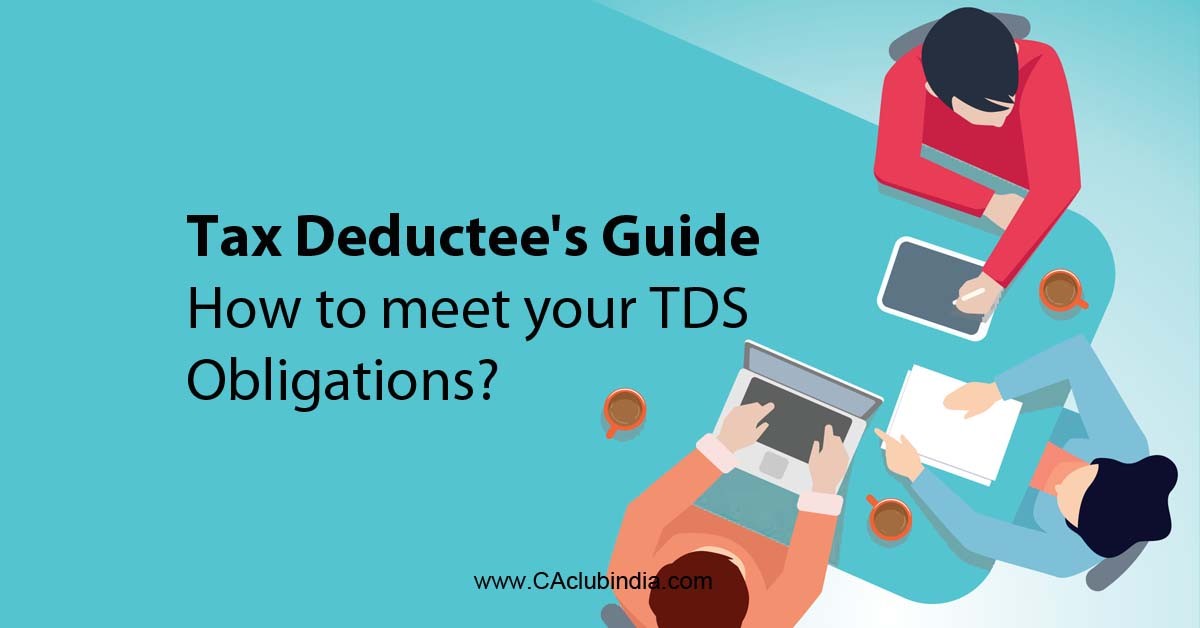Q.1 Who is a deductor and a deductee?
Ans: In case of certain prescribed payments (e. g. Interest, commission, brokerage, rent, etc.) the person making payment is required to deduct tax at source (TDS) at the prescribed rate. The payer is known as deductor and the payee, who receives the net payment is called the deductee.
Q.2 Is deductee required to furnish his permanent account number (PAN) to the deductor?
Ans:
- Every deductee must furnish a valid PAN to the deductor.
- Incorrect PAN may lead to TDS mismatch in the hands of deductee.
- No PAN would result in TDS at higher of following rates.
a) The rate prescribed in the Act; or
b) At the rate in force; or
c) At the rate of 20%
- Rs. 10,000/- penalty may be levied for failure to furnish correct PAN
- PAN needs to be in active state
- PAN status may be verified from e-filing site (www.incometaxindia.gov.in)
- In case of PAN is in in-active state, jurisdictional AO needs to be contacted.

Q.3 Can the deductee claim a lower deduction of tax?
Ans:
- Any person (other than company and partnership firm) can furnish Form No. 15G/15H to the deductor for non-deduction of tax in certain cases.
- For filing Form No. 15G/15H, valid and active PAN is required.
- Any false statement in the declaration shall make the person liable for prosecution u/s 277 where rigorous imprisonment and fine can be imposed.
Q.4 How a company/firm can get lower deduction certificate?
Ans:
- Any potential tax deductee (including company and firm) can apply online only before the TDS Assessing Officer (AO) in Form 13 for lower deduction of tax against certain payments, u/s 197 of the Income Tax Act.
- Only system generated certificate issued by TDS Assessing officer is valid for non-deduction/lower deduction of tax
- Genuineness of 197 certificate can be checked in TRACES (www.tdscpc.gov.in)
Q.5 Is the deductor required to supply a TDS certificate to deductee?
Ans:
- Yes.
- TDS certificate for salary to be issued in - Form no. 16 (issued annually).
- TDS certificate for other than salary - Form no. 16A (issued quarterly).
- F 16/ F 16A is valid only if downloaded from TRACES with 7 digit certificate.
- Duplicate F 16/ F 16A can be issued by deductor.
- Genuineness of F 16/F 16A can be checked online in TRACES.
Q.6 What are the online facilities for taxpayers on TRACES (www.tdscpc.gov.in) ?
Ans:
- View and download
- Annual Tax Credit Statements in Form 26AS.
- TDS Certificate in form No. 16B in case of TDS on Sale of Immovable Property.
- Verification of TDS certificate (Form 16/16A)
- Aggregate TDS Compliance report for corporates/banks provides details of TDS demands of all TANs belonging to one PAN.
- Form No. 26QB (challan cum statement) filed by buyer for TDS made on sale of immovable property.
- Correction of Form no. 26QB.
- Request for resolution of grievance.
Note: Tax Payers can access TRACES website from outside India by using the URL: www.nriservices.tdscpc. gov.in
Q.7 Can deductee cross check the tax credit by viewing Form 26AS?
Ans:
- Yes.
- 26AS is an annual tax statement containing all tax-related transactions against PAN of the deductee.
- In case of non-receipt of Form no. 16/Form no. 16(A), 26AS provides all necessary details.
- Every deductee must check 26AS before filing ITR.
- 26AS also shows all tax payments through challan, issue of refund, etc.
Q.8 What if the deductee notices any inconsistency between actual tax deducted and tax credit as per Form 26AS?
Ans: In case of any inconsistency found in 26AS, deductor needs to be contacted for correction.
Last part of 26AS shows who should be contacted in case of clarification.
Q.9 How can a mismatch in tax credit status of a deductee in form 26AS and actual tax deducted arise?
Ans:
- Non-quoting/incorrect quoting of PAN in TDS statement
- Non-filing of TDS statement by the deductor.
- Non-payment of TDS by the deductor to Government account
- Note: Status of filing TDS statement can be checked online at TRACES.
Q.10 What are the consequences of a mismatch?
Ans:
- Non credit of due tax
- Raising of tax demand by the Income Tax Department
- Reduction in refund claimed
- Additional demand in the form of interest etc due to non-credit of tax.
Q.11 How to avoid mismatch?
Ans:
- Quote correct PAN in all tax related document/ transaction.
- Check 26 AS regularly/quarterly.
- Contact the deductor in case of mismatch in 26AS.
- Deductor can file correction statement to rectify mistake in TDS statement.
Q.12 How can the deductee claim correct credit of all TDS?
Ans:
- Correct tax credit needs to be claimed in ITR.
- Please check all the relevant information like TAN, period, amount credited, tax credit, etc. before claiming in ITR.
Q.13 What are TDS provisions for sale of Immovable property by a resident?
Ans:
- TDS needs to be made on sale of immovable property exceeding Rs. 50 lakh (u/s 194 IA).
- The purchaser needs to deduct tax @1% against PAN of the seller and deposit tax within 30 days from month end.
- TDS is to be reported in Form 26QB (Challan cum statement) online at TIN-NSDL.
- Tax payment is available online/offline.
- 26 QB correction is available on TRACES.
Q.14 How to correct Form no. 26QB?
Ans: Following fields of 26QB statement can be corrected online at TRACES
- PAN of Buyer
- PAN of seller
- Amount Paid/Credited
- Date of Payment/Credit
- Date of Tax Deduction
- Financial Year
- Property details
Note: Please refer to the FAQ's and e-tutorials (www.tdscpc.gov.in) on 26QB corrections for any assistance with the above.
Q.15 Do one need to deduct TDS in the case when the payer is an Individual or HUF and does not require to get its books of account audited as per the IT Act?
Ans: Yes, from September 1, 2019, an individual or HUF paying any sum to a contractor or a professional or commission or brokerage more than Rs 50 lakh in a financial year would be required to deduct tax at source (TDS) at the time of credit of such sum or at the time of payment of such sum; whichever is earlier.
The Government of India vide Finance Act (No 2) 2019, recently introduced section 194M in the Income-tax Act, 1961, making it mandatory for an individual or HUF to withhold taxes at 5% on such payments. However, this section applies only to those individuals and HUFs whose accounts are not required to be audited for tax purposes as mentioned u/s 44AB of the Income Tax Act.
Earlier, only individuals and HUFs who were mandatorily required to have their accounts audited as per the tax laws were required to deduct tax at source (TDS) on contractual, professional and commission or brokerage payments under sections 194C, 1941 and 194H of the Act, respectively.
Q.16 Who is the payee under Sec 194M?
Ans: The payee could be any person, i.e., individual, company, firm etc. but who is a resident of India and who has rendered contractual services, professional services or services for which he is liable to be remunerated either in the form of commission or brokerage.
Q.17 Is there any TDS requirement on the cash withdrawal from the bank accounts?
Ans: The government has introduced section 194N in the union Budget 2019 proposed on 5 July 2019. In order to discourage cash transactions in the country and promote the digital economy, 'Section 194N - TDS on cash withdrawals over and above Rs 1 crore' has been introduced through the Finance Bill, 2019.
Q.18 What is the applicability of section 194N of the Income Tax Act?
Ans: Section 194N is applicable in case of cash withdrawals of more than Rs 1 crore during a financial year. This section will apply to all the sum of money or an aggregate of sums withdrawn from a particular payer in a financial year.
The section will apply to withdrawals made by any taxpayer including:
- An Individual
- A Hindu Undivided Family (HUF)
- A Company
- A partnership firm or an LLP
- A local authority
- An Association of Person (A0Ps) or Body of Individuals (BOIs)
The following payers are covered under this section
- Any bank (private or public sector)
- A co-operative bank
- A post office
The tax will be deducted by the payer while making payment to any individual in cash from a taxpayer's bank account on the amount in excess of Rs 1 crore.
Rate of TDS u/s 194N
The payer will have to deduct TDS @2% on the cash payments/withdrawals of more than Rs. 1 crore in a financial year.
Q.19 How to request for Resolution of mismatches?
Ans: Taxpayers may raise their grievances related to TDS mismatches, missing entries in 26AS, unable to view 26AS, TRACES generated TDS certificate not issued and Transaction not belonging to that PAN through “Request for Resolution” functionality available on TRACES (www.tdscpc.gov.in) with screen print of the error, if required.
Taxpayer/Employee/Deductee
- A person may furnish following details to his employee and the employer shall take into account such details while computing tax deductible from such person's
- Loss under head, 'Income from house property'.
- Any taxable amount under any other head of income (not being a loss).
- Do not claim perquisites/allowances as exempt unless it is allowed by Income Tax Act.
- Do not submit wrong evidence/proof to support your claim.
- Proof of claims provided by you to your employer can be subjected to scrutiny/verification by Income Tax Authority.
- Penalty can be imposed for making wrong claims.
DEDUCTOR/EMPLOYER
- Deduct TDS at the time of payment of salary as per rates in force. Employer must also consider taxable income under any other head and loss from house property.
- Perquisites are taxable as per the provisions of the Act, and subject to TDS.
- DDOs/Deductors must obtain evidence/proof of claim of deductee for lower tax deduction.
- Deduct and deposit tax in Government Account before the due date. Failure to deduct TDS or failure to pay in Government account shall attract Interest, Penalty &
- Issue certificate of tax deduction in Form No. 16 or 16A to the deductee (download from TRACES website).
Also: Click here to download the article as a PDF attachment







 CAclubindia
CAclubindia

